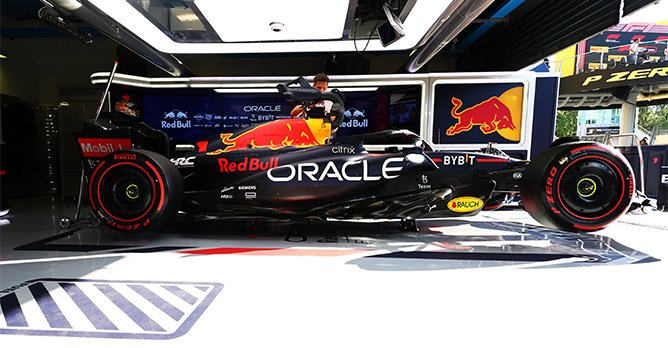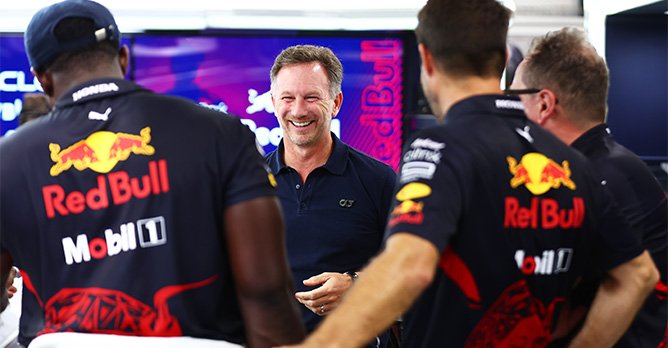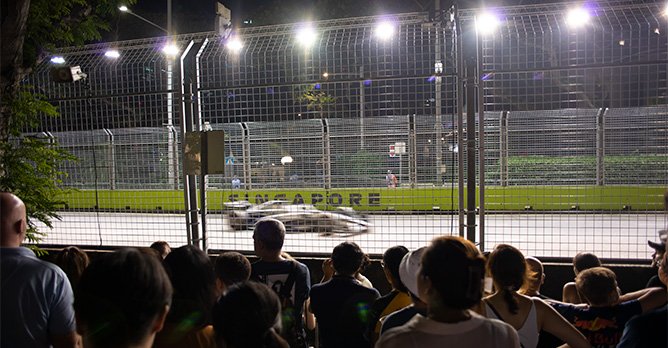'Not overtaking the traditional way': How big tech plays a role in Formula One race wins for Oracle Red Bull Racing
03 Oct 2022|3,229 views
An experienced driver of the sharpest instincts, possessing immense physical-mental endurance. A powerful and reliable powertrain, paired to a structurally-sound, aerodynamic body. And of course, a highly skilled, lightning-quick pit crew. These are the ingredients most commonly associated with the winning recipe for a Formula One race.
But there is yet another pivotal component that most fans either camping on the grandstand or back at home on their sofas don't always see: Data.
A winning strategy, and the importance of Fridays
Where winning comes down not just to seconds, but milliseconds, even the most minute decisions can make the hugest of impacts. In turn, a championship strategy has to consider every single outcome.
In a Formula One race, at least one pit stop has to be made, and two tyre compounds must be used; there are three - soft, medium, hard - for dry conditions, and two for wet races. But even assuming a straightforward race (i.e. no rain), "there is still a lot of decision making, in terms of which lap you make that stop, and which combination of tyres you're using", Zoe Chilton, Head of Partnerships, Oracle Red Bull Racing, tells us.
When the currently-dominating RB18 car was unveiled for the 2022 season, its fresh livery saw Oracle rise to new prominence (liveries are sacred ground, especially in Formula One). Once 'merely' a major sponsor and technical partner, the software giant has ascended since season-start to become title partner.
We're no technical experts here at Sgcarmart, but one way of understanding the significance of the team's name now being Oracle Red Bull Racing is perhaps by zooming in on everyone's favourite day of the week: Friday.
While focus is normally placed on Saturday's qualifiers since they determine starting positions for the race, "Friday is a very important day for us, because we learn an awful lot about how the characteristics of the circuit are this weekend”, Chilton tells us. "We have data from past races, but we don't have everything from how it is just this week, in these specific conditions."
In particular, our sunny island provides a different challenge not simply because its tarmac hasn't been used for two years, but because it's used by us - normal drivers - for the rest of the year. "The track surface is completely different, it behaves differently and it interacts (differently) with our tyres. Learning about that when you arrive is very important", Chilton notes.
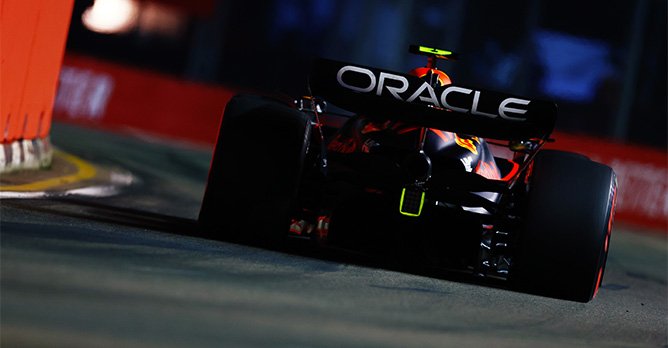
 The street circuit nature of the Singapore GP changes the way the car (and its tyres) interacts with the track The end result is vast chunks of information captured, with which what is called a Monte Carlo Simulation is run. This is where Oracle comes into play. Unlike the ones hanging over Formula One weekend, this firm's own cloud (infrastructure) provides unprecedented assurance to the team by helping to power its own simulations of how various inputs and decisions will unfold towards varying results.
The street circuit nature of the Singapore GP changes the way the car (and its tyres) interacts with the track The end result is vast chunks of information captured, with which what is called a Monte Carlo Simulation is run. This is where Oracle comes into play. Unlike the ones hanging over Formula One weekend, this firm's own cloud (infrastructure) provides unprecedented assurance to the team by helping to power its own simulations of how various inputs and decisions will unfold towards varying results.
"It takes all those facts we've learned from research - data captured on Friday and Saturday - and it uses that to look at millions of possible outcomes in the race," Chilton explains. "That means we have a good picture - hopefully - going into the race on Sunday morning, where we will finish."
Not overtaking the traditional way
Besides providing extra stability to process the data at breakneck-speed, Oracle's cloud infrastructure is also much more flexible, scalable and high-performance than what the team had previously used.
To put this into a figure, it's helped the team perform up to 25% more simulations than before for race outcomes. And to ground this in a real-life scenario, look no further back than the decisive last race of the 2021 season that saw Max Verstappen clinch the World Drivers' Championship. The maiden Monaco win of teammate (and winner of the 2022 Singapore GP's checkered flag), Sergio Perez, in May this year was also credited to the team's strategy.
Even Team Principal for Oracle Red Bull Red Racing, Christian Horner, has credited the simulations run with the cloud infrastructure as key to the team's decision-making at these particular critical junctures, among the many others the team is constantly confronted with.
In all, the partnership is a reminder that winning cannot just be distilled to the raw driving ability of the driver, or prowess of the engineering folk.
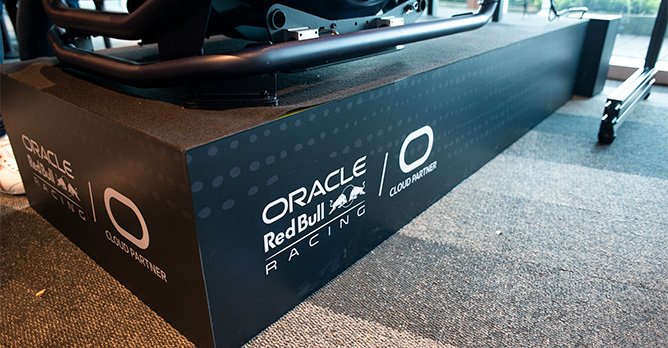
 Oracle's cloud infrastructure plays a pivotal role in running the simulations required for race strategy This season, "[the team] is seeing a few examples where we haven't necessarily overtaken the traditional way, we've overtaken by getting our strategy right and making the pit-stop at the right moment", Chilton points out. "There are many ways to win a Formula One race - they are all legitimate, they are all technology and data-driven, but when we use strategy, it gives us extra choices."
Oracle's cloud infrastructure plays a pivotal role in running the simulations required for race strategy This season, "[the team] is seeing a few examples where we haven't necessarily overtaken the traditional way, we've overtaken by getting our strategy right and making the pit-stop at the right moment", Chilton points out. "There are many ways to win a Formula One race - they are all legitimate, they are all technology and data-driven, but when we use strategy, it gives us extra choices."
In fact, the net for this close technological partnership is being cast even further out - all the way to 2026.
Like the rest of the world, Formula One isn't exempt from the crushing G-forces of accelerating climate change: The new powertrain regulations slated for 2026 are supposed to help the sport in its trek to carbon-neutrality, and Red Bull is taking the chance to develop its own powertrain in the process.
To this end, Oracle's cloud infrastructure will also help to optimise modelling of the new engine combustion chamber, as well as aid internal simulations involving the analysis of computational fluid dynamics, and wind tunnel testing.
The race itself
But back to the racing itself - what about everything that happens on Sunday evening during the actual Grand Prix?
Sudden changes, like the appearance of the safety car, or the weather suddenly changing - as anyone watching the race would have surely seen - "will not always be predicted by the simulation", Chilton admits (although weather forecasts are definitely part of the considerations). But that's where "that speed of the simulation becomes very important then, because we can actually rework it."
Naturally, too, there is one element that cannot be controlled by even the best simulations, powered by the most robust cloud infrastructure: The driver. As an example, Verstappen's reflections post-Hungary victory in July indicated that the data had initially suggested a hard tyre-centric strategy, but he ultimately convinced the team for a switch to soft-tyres when out on the track that day.
The unavoidable reality that emotions run high in the race, however, means that being led by data is ultimately still the best way forward. When asked herself if the human factor is crucial in judgement calls, Chilton has the perfect reply.
"The humans keeping a cool head and trusting the data is crucial. And we have some very strong strategists, so I think we're in a good place there. They're very cool and chill, even in this heat."
Here are other stories that may interest you:
Should you care about Formula E?
A day with the Alfa Romeo Sauber F1 Team
10 things that differentiate Formula E from Formula One
But there is yet another pivotal component that most fans either camping on the grandstand or back at home on their sofas don't always see: Data.
A winning strategy, and the importance of Fridays
Where winning comes down not just to seconds, but milliseconds, even the most minute decisions can make the hugest of impacts. In turn, a championship strategy has to consider every single outcome.
In a Formula One race, at least one pit stop has to be made, and two tyre compounds must be used; there are three - soft, medium, hard - for dry conditions, and two for wet races. But even assuming a straightforward race (i.e. no rain), "there is still a lot of decision making, in terms of which lap you make that stop, and which combination of tyres you're using", Zoe Chilton, Head of Partnerships, Oracle Red Bull Racing, tells us.
When the currently-dominating RB18 car was unveiled for the 2022 season, its fresh livery saw Oracle rise to new prominence (liveries are sacred ground, especially in Formula One). Once 'merely' a major sponsor and technical partner, the software giant has ascended since season-start to become title partner.
We're no technical experts here at Sgcarmart, but one way of understanding the significance of the team's name now being Oracle Red Bull Racing is perhaps by zooming in on everyone's favourite day of the week: Friday.
While focus is normally placed on Saturday's qualifiers since they determine starting positions for the race, "Friday is a very important day for us, because we learn an awful lot about how the characteristics of the circuit are this weekend”, Chilton tells us. "We have data from past races, but we don't have everything from how it is just this week, in these specific conditions."
In particular, our sunny island provides a different challenge not simply because its tarmac hasn't been used for two years, but because it's used by us - normal drivers - for the rest of the year. "The track surface is completely different, it behaves differently and it interacts (differently) with our tyres. Learning about that when you arrive is very important", Chilton notes.

"It takes all those facts we've learned from research - data captured on Friday and Saturday - and it uses that to look at millions of possible outcomes in the race," Chilton explains. "That means we have a good picture - hopefully - going into the race on Sunday morning, where we will finish."
Not overtaking the traditional way
Besides providing extra stability to process the data at breakneck-speed, Oracle's cloud infrastructure is also much more flexible, scalable and high-performance than what the team had previously used.
To put this into a figure, it's helped the team perform up to 25% more simulations than before for race outcomes. And to ground this in a real-life scenario, look no further back than the decisive last race of the 2021 season that saw Max Verstappen clinch the World Drivers' Championship. The maiden Monaco win of teammate (and winner of the 2022 Singapore GP's checkered flag), Sergio Perez, in May this year was also credited to the team's strategy.
Even Team Principal for Oracle Red Bull Red Racing, Christian Horner, has credited the simulations run with the cloud infrastructure as key to the team's decision-making at these particular critical junctures, among the many others the team is constantly confronted with.
In all, the partnership is a reminder that winning cannot just be distilled to the raw driving ability of the driver, or prowess of the engineering folk.

In fact, the net for this close technological partnership is being cast even further out - all the way to 2026.
Like the rest of the world, Formula One isn't exempt from the crushing G-forces of accelerating climate change: The new powertrain regulations slated for 2026 are supposed to help the sport in its trek to carbon-neutrality, and Red Bull is taking the chance to develop its own powertrain in the process.
To this end, Oracle's cloud infrastructure will also help to optimise modelling of the new engine combustion chamber, as well as aid internal simulations involving the analysis of computational fluid dynamics, and wind tunnel testing.
The race itself
But back to the racing itself - what about everything that happens on Sunday evening during the actual Grand Prix?
Sudden changes, like the appearance of the safety car, or the weather suddenly changing - as anyone watching the race would have surely seen - "will not always be predicted by the simulation", Chilton admits (although weather forecasts are definitely part of the considerations). But that's where "that speed of the simulation becomes very important then, because we can actually rework it."
Naturally, too, there is one element that cannot be controlled by even the best simulations, powered by the most robust cloud infrastructure: The driver. As an example, Verstappen's reflections post-Hungary victory in July indicated that the data had initially suggested a hard tyre-centric strategy, but he ultimately convinced the team for a switch to soft-tyres when out on the track that day.
The unavoidable reality that emotions run high in the race, however, means that being led by data is ultimately still the best way forward. When asked herself if the human factor is crucial in judgement calls, Chilton has the perfect reply.
"The humans keeping a cool head and trusting the data is crucial. And we have some very strong strategists, so I think we're in a good place there. They're very cool and chill, even in this heat."
Here are other stories that may interest you:
Should you care about Formula E?
A day with the Alfa Romeo Sauber F1 Team
10 things that differentiate Formula E from Formula One
An experienced driver of the sharpest instincts, possessing immense physical-mental endurance. A powerful and reliable powertrain, paired to a structurally-sound, aerodynamic body. And of course, a highly skilled, lightning-quick pit crew. These are the ingredients most commonly associated with the winning recipe for a Formula One race.
But there is yet another pivotal component that most fans either camping on the grandstand or back at home on their sofas don't always see: Data.
A winning strategy, and the importance of Fridays
Where winning comes down not just to seconds, but milliseconds, even the most minute decisions can make the hugest of impacts. In turn, a championship strategy has to consider every single outcome.
In a Formula One race, at least one pit stop has to be made, and two tyre compounds must be used; there are three - soft, medium, hard - for dry conditions, and two for wet races. But even assuming a straightforward race (i.e. no rain), "there is still a lot of decision making, in terms of which lap you make that stop, and which combination of tyres you're using", Zoe Chilton, Head of Partnerships, Oracle Red Bull Racing, tells us.
When the currently-dominating RB18 car was unveiled for the 2022 season, its fresh livery saw Oracle rise to new prominence (liveries are sacred ground, especially in Formula One). Once 'merely' a major sponsor and technical partner, the software giant has ascended since season-start to become title partner.
We're no technical experts here at Sgcarmart, but one way of understanding the significance of the team's name now being Oracle Red Bull Racing is perhaps by zooming in on everyone's favourite day of the week: Friday.
While focus is normally placed on Saturday's qualifiers since they determine starting positions for the race, "Friday is a very important day for us, because we learn an awful lot about how the characteristics of the circuit are this weekend”, Chilton tells us. "We have data from past races, but we don't have everything from how it is just this week, in these specific conditions."
In particular, our sunny island provides a different challenge not simply because its tarmac hasn't been used for two years, but because it's used by us - normal drivers - for the rest of the year. "The track surface is completely different, it behaves differently and it interacts (differently) with our tyres. Learning about that when you arrive is very important", Chilton notes.

 The street circuit nature of the Singapore GP changes the way the car (and its tyres) interacts with the track The end result is vast chunks of information captured, with which what is called a Monte Carlo Simulation is run. This is where Oracle comes into play. Unlike the ones hanging over Formula One weekend, this firm's own cloud (infrastructure) provides unprecedented assurance to the team by helping to power its own simulations of how various inputs and decisions will unfold towards varying results.
The street circuit nature of the Singapore GP changes the way the car (and its tyres) interacts with the track The end result is vast chunks of information captured, with which what is called a Monte Carlo Simulation is run. This is where Oracle comes into play. Unlike the ones hanging over Formula One weekend, this firm's own cloud (infrastructure) provides unprecedented assurance to the team by helping to power its own simulations of how various inputs and decisions will unfold towards varying results.
"It takes all those facts we've learned from research - data captured on Friday and Saturday - and it uses that to look at millions of possible outcomes in the race," Chilton explains. "That means we have a good picture - hopefully - going into the race on Sunday morning, where we will finish."
Not overtaking the traditional way
Besides providing extra stability to process the data at breakneck-speed, Oracle's cloud infrastructure is also much more flexible, scalable and high-performance than what the team had previously used.
To put this into a figure, it's helped the team perform up to 25% more simulations than before for race outcomes. And to ground this in a real-life scenario, look no further back than the decisive last race of the 2021 season that saw Max Verstappen clinch the World Drivers' Championship. The maiden Monaco win of teammate (and winner of the 2022 Singapore GP's checkered flag), Sergio Perez, in May this year was also credited to the team's strategy.
Even Team Principal for Oracle Red Bull Red Racing, Christian Horner, has credited the simulations run with the cloud infrastructure as key to the team's decision-making at these particular critical junctures, among the many others the team is constantly confronted with.
In all, the partnership is a reminder that winning cannot just be distilled to the raw driving ability of the driver, or prowess of the engineering folk.


Oracle's cloud infrastructure plays a pivotal role in running the simulations required for race strategy This season, "[the team] is seeing a few examples where we haven't necessarily overtaken the traditional way, we've overtaken by getting our strategy right and making the pit-stop at the right moment", Chilton points out. "There are many ways to win a Formula One race - they are all legitimate, they are all technology and data-driven, but when we use strategy, it gives us extra choices."
In fact, the net for this close technological partnership is being cast even further out - all the way to 2026.
Like the rest of the world, Formula One isn't exempt from the crushing G-forces of accelerating climate change: The new powertrain regulations slated for 2026 are supposed to help the sport in its trek to carbon-neutrality, and Red Bull is taking the chance to develop its own powertrain in the process.
To this end, Oracle's cloud infrastructure will also help to optimise modelling of the new engine combustion chamber, as well as aid internal simulations involving the analysis of computational fluid dynamics, and wind tunnel testing.
The race itself
But back to the racing itself - what about everything that happens on Sunday evening during the actual Grand Prix?
Sudden changes, like the appearance of the safety car, or the weather suddenly changing - as anyone watching the race would have surely seen - "will not always be predicted by the simulation", Chilton admits (although weather forecasts are definitely part of the considerations). But that's where "that speed of the simulation becomes very important then, because we can actually rework it."
Naturally, too, there is one element that cannot be controlled by even the best simulations, powered by the most robust cloud infrastructure: The driver. As an example, Verstappen's reflections post-Hungary victory in July indicated that the data had initially suggested a hard tyre-centric strategy, but he ultimately convinced the team for a switch to soft-tyres when out on the track that day.
The unavoidable reality that emotions run high in the race, however, means that being led by data is ultimately still the best way forward. When asked herself if the human factor is crucial in judgement calls, Chilton has the perfect reply.
"The humans keeping a cool head and trusting the data is crucial. And we have some very strong strategists, so I think we're in a good place there. They're very cool and chill, even in this heat."
Here are other stories that may interest you:
Should you care about Formula E?
A day with the Alfa Romeo Sauber F1 Team
10 things that differentiate Formula E from Formula One
But there is yet another pivotal component that most fans either camping on the grandstand or back at home on their sofas don't always see: Data.
A winning strategy, and the importance of Fridays
Where winning comes down not just to seconds, but milliseconds, even the most minute decisions can make the hugest of impacts. In turn, a championship strategy has to consider every single outcome.
In a Formula One race, at least one pit stop has to be made, and two tyre compounds must be used; there are three - soft, medium, hard - for dry conditions, and two for wet races. But even assuming a straightforward race (i.e. no rain), "there is still a lot of decision making, in terms of which lap you make that stop, and which combination of tyres you're using", Zoe Chilton, Head of Partnerships, Oracle Red Bull Racing, tells us.
When the currently-dominating RB18 car was unveiled for the 2022 season, its fresh livery saw Oracle rise to new prominence (liveries are sacred ground, especially in Formula One). Once 'merely' a major sponsor and technical partner, the software giant has ascended since season-start to become title partner.
We're no technical experts here at Sgcarmart, but one way of understanding the significance of the team's name now being Oracle Red Bull Racing is perhaps by zooming in on everyone's favourite day of the week: Friday.
While focus is normally placed on Saturday's qualifiers since they determine starting positions for the race, "Friday is a very important day for us, because we learn an awful lot about how the characteristics of the circuit are this weekend”, Chilton tells us. "We have data from past races, but we don't have everything from how it is just this week, in these specific conditions."
In particular, our sunny island provides a different challenge not simply because its tarmac hasn't been used for two years, but because it's used by us - normal drivers - for the rest of the year. "The track surface is completely different, it behaves differently and it interacts (differently) with our tyres. Learning about that when you arrive is very important", Chilton notes.

"It takes all those facts we've learned from research - data captured on Friday and Saturday - and it uses that to look at millions of possible outcomes in the race," Chilton explains. "That means we have a good picture - hopefully - going into the race on Sunday morning, where we will finish."
Not overtaking the traditional way
Besides providing extra stability to process the data at breakneck-speed, Oracle's cloud infrastructure is also much more flexible, scalable and high-performance than what the team had previously used.
To put this into a figure, it's helped the team perform up to 25% more simulations than before for race outcomes. And to ground this in a real-life scenario, look no further back than the decisive last race of the 2021 season that saw Max Verstappen clinch the World Drivers' Championship. The maiden Monaco win of teammate (and winner of the 2022 Singapore GP's checkered flag), Sergio Perez, in May this year was also credited to the team's strategy.
Even Team Principal for Oracle Red Bull Red Racing, Christian Horner, has credited the simulations run with the cloud infrastructure as key to the team's decision-making at these particular critical junctures, among the many others the team is constantly confronted with.
In all, the partnership is a reminder that winning cannot just be distilled to the raw driving ability of the driver, or prowess of the engineering folk.

Oracle's cloud infrastructure plays a pivotal role in running the simulations required for race strategy
In fact, the net for this close technological partnership is being cast even further out - all the way to 2026.
Like the rest of the world, Formula One isn't exempt from the crushing G-forces of accelerating climate change: The new powertrain regulations slated for 2026 are supposed to help the sport in its trek to carbon-neutrality, and Red Bull is taking the chance to develop its own powertrain in the process.
To this end, Oracle's cloud infrastructure will also help to optimise modelling of the new engine combustion chamber, as well as aid internal simulations involving the analysis of computational fluid dynamics, and wind tunnel testing.
The race itself
But back to the racing itself - what about everything that happens on Sunday evening during the actual Grand Prix?
Sudden changes, like the appearance of the safety car, or the weather suddenly changing - as anyone watching the race would have surely seen - "will not always be predicted by the simulation", Chilton admits (although weather forecasts are definitely part of the considerations). But that's where "that speed of the simulation becomes very important then, because we can actually rework it."
Naturally, too, there is one element that cannot be controlled by even the best simulations, powered by the most robust cloud infrastructure: The driver. As an example, Verstappen's reflections post-Hungary victory in July indicated that the data had initially suggested a hard tyre-centric strategy, but he ultimately convinced the team for a switch to soft-tyres when out on the track that day.
The unavoidable reality that emotions run high in the race, however, means that being led by data is ultimately still the best way forward. When asked herself if the human factor is crucial in judgement calls, Chilton has the perfect reply.
"The humans keeping a cool head and trusting the data is crucial. And we have some very strong strategists, so I think we're in a good place there. They're very cool and chill, even in this heat."
Here are other stories that may interest you:
Should you care about Formula E?
A day with the Alfa Romeo Sauber F1 Team
10 things that differentiate Formula E from Formula One
Thank You For Your Subscription.



























